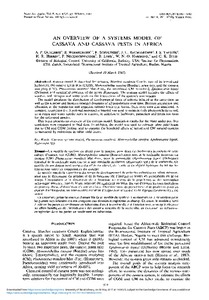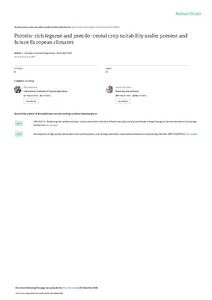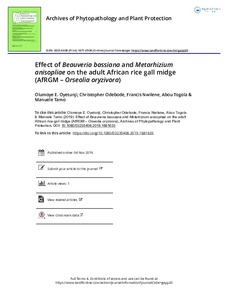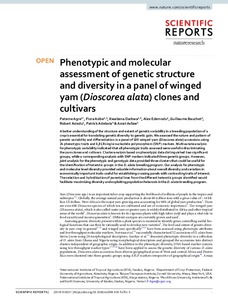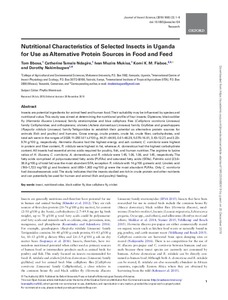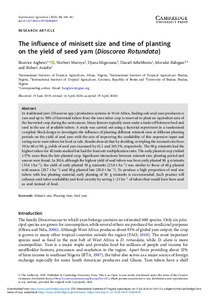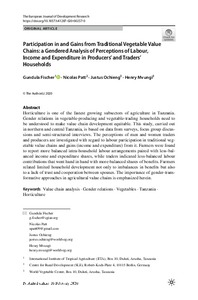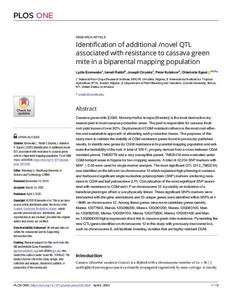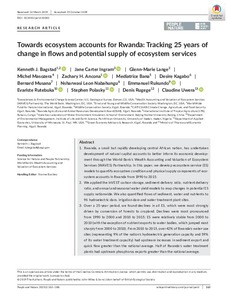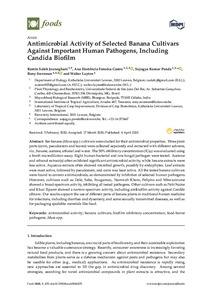Welcome to the International Institute of Tropical Agriculture Research Repository
Journal and Journal Articles: Recent submissions
Now showing items 1101-1120 of 5157
-
Melanization of eggs and larvae of the parasitoid, Epidinocarsis lopezi (Hymenoptera: Encyrtidae), by the cassava mealybug, Phenacoccus manihoti (Homoptera:Pseudococcidae)
(1988)The encyrtid wasp Epidinocarsis lopezi (De Santis) has been introduced into Africa as a biological control agent against the cassava mealybug Phenacoccus manihoti Matile-Ferrero. This host has a defense reaction against the immature parasitoid that involves encapsulation and melanization. Under laboratory conditions, 37.5% of once-stung cassava mealybugs had been parasitized, as indicated by eggs and larvae of the parasitoid in dissected hosts. Of these parasitized cassava mealybugs, 89.6% contained ... -
Changes in the composition of the fauna associated with the cassava mealybug, Phenacoccus manihoti, following the introduction of the parasitoid Epidinocarsis lopezi
(1987-12)Over 130 species of insects were found in association with the cassava mealybug (CM), Phenacoccus manihoti, and its newly introduced parasitoid Epidinocarsis lopezi in Africa. As the CM in SW Nigeria declined under the influence of E. lopezi, this introduced wasp maintained densities of 2.8-3 per CM-infested tip early in the dry season and 1.3-1.6 per infested tip late in the dry season, but declined overall from 1.3 to 0.2 per randomly collected tip within 1 year. The decline of CM led to a sharp ... -
Introduction and dispersal of Epidinocarsis lopezi (Hym., Encyrtidae), an exotic parasitoid of the cassava mealybug, Phenacoccus manihoti (Hom., Pseudococcidae), in Africa
(1987-06)In 1981 the South American parasitoid Epidinocarsis lopezi (DeSantis) was imported into Nigeria for control of the cassava mealybug, Phenacoccus manihoti Mat.-Ferr. It was multiplied in an insectary at the International Institute of Tropical Agriculture (IITA), Ibadan, and first released in 1981/82. Within 3 years it dispersed over 200 000 km2 in southwestern Nigeria, occupying between 70 and 98% of all fields. By December 1985, a total of over 50 releases in 34 regions had been made in 12 African ... -
Impact of the exotic parasitoid Epidinocarsis lopezi on cassava mealybug (Phenacoccus manihoti) populations
(1987-12)Epidinocarsis lopezi an exotic parasitoid to Africa, was first released to control the cassava mealybug (CM), Phenacoccus manihoti, at IITA (Ibadan) in November 1981, and a year later at Abeokuta, both in southwestern Nigeria. Population dynamics study of CM and its natural enemies was conducted for 4 years. CM population peaks usually occurred during the second half of the dry season (January-April). E. lopezi was the only natural enemy that was found during the whole year and in high densities. ... -
An overview of a systems model of cassava and cassava pests in Africa
(1987)A systems model is described for cassava, Manihot esculenta Crantz, two of its introduced herbivores, the cassava green mite (CGM), Mononychellus tanajoa (Bondar), sensu lato, and the cassava mealybug (CM), Phenacoccus manihoti Mat.-Ferr., the introduced CM parasitoid, Epidinocarsis lopezi (DeSantis) and coccinellid predator of the genus Hyperaspis. The systems model includes the effects of weather, soil nitrogen and water levels on the interactions of the system’s components. The model simulates ... -
Using a participatory approach and legume integration to increase the productivity of early maturing maize in the Nigerian Sudan Savannas
(2019)Drought, infestation of cereal crops by the parasitic weed Striga hermonthica, and poor soil fertility are the major constraints to maize production by smallholder farmers in the Sudan savannas of northern Nigeria. Four innovation platforms (IPs) were therefore established in 2008 in the Sudan savanna (SS) agroecological zone of northern Nigeria to create a stakeholder forum to address these identified food production challenges in the target areas. The IPs comprised researchers from Bayero ... -
Review of empirical and emerging breeding methods and tools for yam (Dioscorea spp.) improvement: status and prospects
(2020-06)Yam (Dioscorea spp.) is an important tuber crop with tremendous potential as a functional food in the tropics and subtropics. However, the crop has not shown progressive productivity gain over decades due to various production constraints. This paper reviews the progress achieved in empirical breeding endeavours and the development, status and application of emerging breeding tools and technologies to translate genetic gains in yam improvement. Significant progress has been made in yam genetic ... -
Protein-rich legume and pseudo-cereal crop suitability under present and future European climates
(2020)Replacing animal proteins with plant proteins in diets has been demonstrated to have both health and environmental advantages, driving a debate about the potential of protein-rich crops as dietary replacements for animal products. However, there is a lack of knowledge on how climate change could influence the potential for producing protein-rich crops. This study addresses this knowledge gap for the European Union. We analysed 13 protein-rich crops, using the crop suitability model EcoCrop and ... -
Effect of Beauveria bassiana and Metarhizium anisopliae on the adult African rice gall midge (AfRGM – Orseolia oryzivora)
(2019)Rice is an important staple crop whose production is limited by array of insect pests and diseases. African rice gall midge (AfRGM) Orseolia oryzivora Harris & Gagné (Diptera: Cecidomyiidae) is a major insect pest of lowland rice ecology in Africa. Heavy yield losses have been recorded in many farmers’ rice fields. Use of synthetic insecticides has fostered environmental and human health concern that initiates a search for alternative control measures such as Entomopathogenic fungi (EPF) – Beauveria ... -
Phenotypic and molecular assessment of genetic structure and diversity in a panel of winged yam (Dioscorea alata) clones and cultivars
(2019)A better understanding of the structure and extent of genetic variability in a breeding population of a crop is essential for translating genetic diversity to genetic gain. We assessed the nature and pattern of genetic variability and differentiation in a panel of 100 winged-yam (Dioscorea alata) accessions using 24 phenotypic traits and 6,918 single nucleotide polymorphism (SNP) markers. Multivariate analysis for phenotypic variability indicated that all phenotypic traits assessed were useful in ... -
Nutritional characteristics of selected insects in Uganda for use as alternative protein sources in food and feed
(2019)Insects are potential ingredients for animal feed and human food. Their suitability may be influenced by species and nutritional value. This study was aimed at determining the nutritional profile of four insects: Dipterans; black soldier fly (Hermetia illucens Linnaeus) family stratiomyidae and blue calliphora flies (Calliphora vomitoria Linnaeus) family Calliphoridae; and orthopterans; crickets (Acheta domesticus Linnaeus) family Gryllidae and grasshoppers (Ruspolia nitidula Linnaeus) family ... -
The influence of minisett size and time of planting on the yield of seed yam (Dioscorea Rotundata)
(2020-05-22)In traditional yam (Dioscorea spp.) production systems in West Africa, finding sole seed yam producers is rare and up to 30% of harvested tubers from the ware tuber crop is reserved to plant an equivalent area of the harvested crop during the next season. Many farmers typically must make a trade-off between food and seed in the use of available tubers. A study was carried out using a factorial experiment in a randomised complete block design to investigate the influence of planting different ... -
Participation in and gains from traditional vegetable value chains: a gendered analysis of perceptions of labour, income and expenditure in producers' and traders' households
(2020-02-26)Horticulture is one of the fastest growing subsectors of agriculture in Tanzania. Gender relations in vegetable-producing and vegetable-trading households need to be understood to make value chain development equitable. This study, carried out in northern and central Tanzania, is based on data from surveys, focus group discussions and semi-structured interviews. The perceptions of men and women traders and producers are investigated with regard to labour participation in traditional vegetable value ... -
Identification of additional/novel QTL associated with resistance to cassava green mite in a biparental mapping population
(2020-04-02)Cassava green mite [CGM, Mononychellus tanajoa (Bondar)] is the most destructive dry-season pest in most cassava production areas. The pest is responsible for cassava fresh root yield losses of over 80%. Deployment of CGM resistant cultivars is the most cost-effective and sustainable approach of alleviating such production losses. The purposes of this study were to validate the stability of CGM resistance genes found in previously published results, to identify new genes for CGM resistance in ... -
Towards ecosystem accounts for Rwanda: tracking 25 years of change in flows and potential supply of ecosystem services
(2019-12-09)Rwanda, a small but rapidly developing central African nation, has undertaken development of natural capital accounts to better inform its economic development through the World Bank's Wealth Accounting and Valuation of Ecosystem Services (WAVES) Partnership. In this paper, we develop ecosystem service (ES) models to quantify ecosystem condition and physical supply components of ecosystem accounts in Rwanda from 1990 to 2015. We applied the InVEST carbon storage, sediment delivery ratio, nutrient ... -
Interactions between the female parasitoid Epidinocarsis lopezi De Santis (Hym., Encyrtidae) and its host, the cassava mealybug, Phenacoccus manihoti Matile-Ferrero (Hom., Pseudococcidae)
(1988-12)In laboratory experiments, the influence of different host instars and population densities of the cassava mealybug (CM), Phenacoccus manihoti Matile‐Ferrero, on the reproductive performance of the encyrtid parasitoid Epidinocarsis lopezi (De Santis), was investigated. In choice experiments, fourth instar hosts were examined most frequently, but third instar hosts were stung most often. Stinging was followed by oviposition in 87.7% of all third instar CM, and 57.1% of all second instars. At constant ... -
Screening preemergence herbicides for weed control in cassava
(2020-02-17)Weed competition severely constrains cassava root yield in sub-Saharan Africa; thus, good weed control measures, including the use of herbicides, are increasingly important. Herbicide trials were conducted at five locations across eastern, western, and north-central Nigeria over two cropping seasons (2014 and 2015). Nineteen premixed PRE herbicides applied at different rates were evaluated for efficacy on weeds and selectivity on cassava. Manual hoe-weeding at 4, 8, and 12 wk after planting (WAP) ... -
Antimicrobial activity of selected banana cultivars against important human pathogens, including candida biofilm
(2020-04-04)Ten banana (Musa spp.) cultivars were studied for their antimicrobial properties. Three plant parts (corm, pseudostem and leaves) were collected separately and extracted with different solvents, viz., hexane, acetone, ethanol and water. The 50% inhibitory concentration (IC50) was evaluated using a broth microdilution assay. Eight human bacterial and one fungal pathogen were tested. Acetone and ethanol extract(s) often exhibited significant antimicrobial activity, while hexane extracts were less ...


